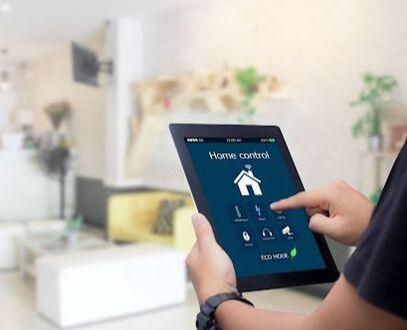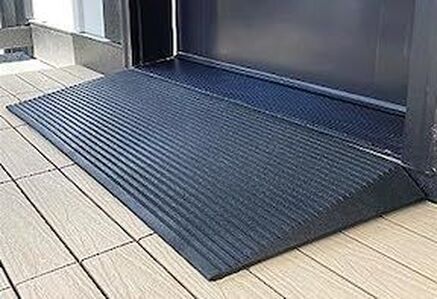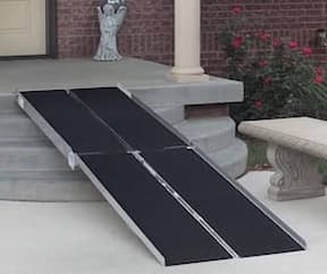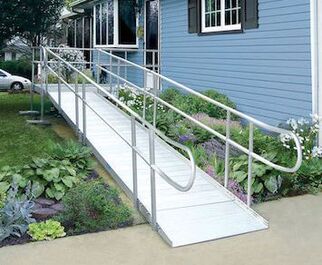|
Using equipment and making simple modifications may be enough to make your home accessible now and into the future. As ALS progresses, maneuvering around your home can become challenging—and the thought of making big renovations or moving can be overwhelming. There are a variety of options, including relatively inexpensive home modifications and adaptive equipment, that may continue to make your home accessible. The physical and occupational therapists at your ALS clinic or home health agency can help you try to find ways to continue to access your home and maintain your independence. |
Assessing Your Options
|
Every home presents its own challenges and opportunities for short-term and long-term accessibility. In order to understand your options, it is important to invite an experienced professional into your home so they can see it in person and make recommendations.
Ask your ALS clinic and/or local ALS organization if a member of their team can do a home visit and assessment. If that is not possible—and if your insurance will cover it—ask your neurologist, clinic coordinator, or primary care provider to arrange a home safety evaluation by a physical or occupational therapist from a home health agency. You can also take photos, videos, and measurements as needed to share with your therapists. Once you have received the information and recommendations from your home assessment, you can begin to think about your short- and long-term options. What are the simple things you can do now to improve your home’s safety and accessibility? What might be your best options for when your mobility is more limited? Thinking ahead and planning for your future needs can help you make timely adjustments and avoid getting stuck in a situation where you have limited accessibility. |
|
Home SafetyAn essential part of home accessibility is home safety. Learn about fall prevention, getting in and out of your home, setting up an emergency alert system, and more on our Home Safety page.
|
Home Modifications without Renovations
|
After your home evaluation is complete, you should have a good understanding of the changes that need to be made so you can be safe and more independent at home.
Clearing pathways and removing tripping hazards is often a good place to start. This may include removing loose throw rugs, cleaning up clutter, and rearranging furniture. Keep in mind that mobility devices like power wheelchairs will require wider pathways and additional space for turning around. |
|
Narrow doorways can also present a problem for some mobility devices. If your doorways are just a little too narrow, you can gain extra space by installing offset hinges, removing the trim, or even removing some interior doors altogether. If your doorways are still too narrow, you may need to hire a contractor to widen them. If you have a power wheelchair, you will want doorways that are at least 32 inches wide.
Flooring is another important factor to take into consideration. Shaggy carpet, or carpet with extra soft padding, for example, can be a problem for walking aids and power wheelchairs, in addition to being a tripping hazard. Smooth, high-impact surfaces that are not too slippery are usually a good option.
Flooring is another important factor to take into consideration. Shaggy carpet, or carpet with extra soft padding, for example, can be a problem for walking aids and power wheelchairs, in addition to being a tripping hazard. Smooth, high-impact surfaces that are not too slippery are usually a good option.
Smart Home TechnologyAnother way you can remain more independent is by using smart home devices that help you do things like turn lights on and off, adjust the thermostat, and open the front door. Learn more on our Smart Home page.
|
Ramps for Home Accessibility
|
Whether you are walking or driving a power wheelchair, there are a wide variety of ramps that can help you continue to access the different parts of your home and property.
If small steps or thresholds are a problem, relatively inexpensive threshold ramps may help. These ramps can be fixed, adjustable, or modular and are often made of rubber, aluminum, or foam. Ramps are not covered by insurance. Ask your local ALS organization if they might be able to lend you one from their equipment loan closet. If you need to pay out of pocket, you can visit our Ramps page. Depending on your state, you may not need to pay sales tax if your doctor provides a prescription for the ramp or lift. |
|
Adaptive Housing Grants for Military VeteransIf you are a U.S. military veteran who qualifies for service-connected benefits, you will receive funding that you can use to modify and adapt your home to make it more accessible. Learn how to access your VA benefits on our Veterans page.
|
|
If prefabricated ramps won’t work for your thresholds or steps, you may need to have a custom ramp built. You may be able to get assistance from local churches, charities, or organizations such as Habitat for Humanity, Elks, and Rotary. Boy Scouts may even be able to build you a custom ramp as a community service project.
If you have questions or concerns, ask a professional for guidance before purchasing, installing, or building ramps for your home. If you have multiple steps outside of your home, you may need a longer custom ramp to help you enter and exit. These wooden or aluminum ramps may be long and even turn, depending on your vertical rise and available space. Ramps will vary in size and length depending on your needs. For safety reasons, ramps should have gradual slopes. The American Disability Act (ADA) requires public ramps to have 12 inches of length for every inch of vertical rise. Also keep in mind that a power wheelchair will need enough room to maneuver at the top and bottom of each ramp. Learn more about wheelchair ramp slope measurements. |
Ask a professional or building contractor to visit your home and suggest the best type of custom ramp for you. To find a good contractor, ask your local ALS organization for recommendations, search online, or ask your chamber of commerce about companies that specialize in wheelchair ramps. If your family, friends, or community want to build you a ramp, here are some tips for measuring and building wheelchair ramps.
Custom ramps are not covered by insurance and often cost $5,000 or more. Ask about financial and material assistance options at your local ALS organization as well as at churches, charities, and community organizations in your area.
Custom ramps are not covered by insurance and often cost $5,000 or more. Ask about financial and material assistance options at your local ALS organization as well as at churches, charities, and community organizations in your area.
Vertical Platform Lifts
|
If you do not have enough room for a ramp to help you get up and down a few steps, you may want to consider getting a vertical platform lift. These motorized lifts can support the weight of a power wheelchair and are typically located either outside the home or in a garage.
Platform lifts can be expensive and are not covered by insurance, though Medicaid may cover them. As always, ask your physical and occupational therapists and local ALS organization if there might be any loaner options or financial assistance available. |
|
Accessing Your Multi-Level Home
|
If you live in a home with one or more sets of stairs, accessing the different levels of your home can become challenging. Depending on the configuration of your stairs, you may be able to install a stair lift, often called a stair glide, to transport you between floors.
Stair lifts are motorized chairs that run up and down on a track mounted to the wall next to your stairs. Stair lifts may not work in every situation, but they can be configured for both straight and curved stairs. Stair lifts can be a great option for people who tire when walking up stairs or who use walking aids or standard wheelchairs and can still assist with transfers. Keep in mind that you may need to leave a second walker or wheelchair at the top or bottom of the stairs to help you move around on that level. |
|
Stair lifts can be expensive and are not covered by insurance. Ask your physical therapist or local ALS organization if you can borrow, rent, or receive financial assistance.
In some instances, it might be possible to install an actual elevator in your home. This can be an expensive option, but if you can afford it, it could provide the best access to the different levels of your home.
If a stair lift will not work for you, or if you have a custom power wheelchair and cannot install an elevator, you will need to think about whether you could spend all or most of your time on one level. This might involve repurposing a room or area to serve as your bedroom. Ideally, you would also have an accessible bathroom on the level. Keep in mind that you will still need to be able to enter and exit your home safely.
If living on the main floor is not a possibility either, you may need to talk with your family and ALS support team about the possibility of moving into a more accessible home or assisted living facility.
In some instances, it might be possible to install an actual elevator in your home. This can be an expensive option, but if you can afford it, it could provide the best access to the different levels of your home.
If a stair lift will not work for you, or if you have a custom power wheelchair and cannot install an elevator, you will need to think about whether you could spend all or most of your time on one level. This might involve repurposing a room or area to serve as your bedroom. Ideally, you would also have an accessible bathroom on the level. Keep in mind that you will still need to be able to enter and exit your home safely.
If living on the main floor is not a possibility either, you may need to talk with your family and ALS support team about the possibility of moving into a more accessible home or assisted living facility.
Bathroom Accessibility
|
Bathrooms tend to have tighter spaces and narrower doorways. If you use a walker and can still walk some on your own, you may be able to leave your walker outside of the bathroom and use strategically placed grab bars to safely maneuver around.
Be sure to remove rugs, bathmats, and other tripping hazards. If you need to use a walker or wheelchair and are unable to widen the doorway enough for them to fit, you may need to transfer to a narrower rolling shower chair before entering your bathroom. Your ability to shower and bathe will depend on the configuration of your tub or shower. Smaller showers with lips can be challenging and may be inaccessible if you aren’t able to step up and over. Grab bars can be added to assist with safety and balance. |
If you have a bathtub, you may be able to use a tub transfer bench or tub slider to help you transfer into and out of the tub. If you have glass shower doors, they will need to be replaced with curtains to accommodate the bench.
Wide roll-in showers offer the most accessibility and flexibility for shower chairs and patient (Hoyer) lifts. A barrier free roll-in shower is the safest option.
If you are unable to bathe in your existing bathroom, you may need to renovate, use a portable shower outside of your bathroom, or take sponge baths.
Another challenge can be using the toilet. Toilet safety frames, raised toilet seats, and toilet seat bidets can help, though some bathrooms may be too small if you need transfer assistance. Options for toileting outside the bathroom include commode chairs, rolling shower commode chairs, portable male and female urinals, condom catheters, and adult diapers. Learn about these and other devices on our Bathing Devices page.
Safety and fall prevention in the bathroom are paramount. You can install grab bars near the toilet and shower as well as safety poles if needed.
Wide roll-in showers offer the most accessibility and flexibility for shower chairs and patient (Hoyer) lifts. A barrier free roll-in shower is the safest option.
If you are unable to bathe in your existing bathroom, you may need to renovate, use a portable shower outside of your bathroom, or take sponge baths.
Another challenge can be using the toilet. Toilet safety frames, raised toilet seats, and toilet seat bidets can help, though some bathrooms may be too small if you need transfer assistance. Options for toileting outside the bathroom include commode chairs, rolling shower commode chairs, portable male and female urinals, condom catheters, and adult diapers. Learn about these and other devices on our Bathing Devices page.
Safety and fall prevention in the bathroom are paramount. You can install grab bars near the toilet and shower as well as safety poles if needed.
ALS Home Renovation Video SeriesIf you are considering making home renovations, Matt's Place Foundation has developed a video series meant to serve as a guide for remodeling your home. Watch videos
|
Deciding to Renovate
|
If you are unable to make your home more accessible by using adaptive equipment and making smaller changes, you may want to consider remodeling the areas of your home that present the greatest challenges. Deciding to renovate is a personal decision that will depend on your finances, home layout, disease progression, care support, and other factors.
Home renovation projects can be disruptive to your daily lives and take longer than expected. They can also be expensive—and go over budget. Home accessibility renovations are not covered by insurance unless you are a U.S. military veteran. When deciding which changes to make, it may be helpful to reflect on your priorities. What is most important to you? Accessing your shower? Getting outside easily? Spending time with others? |
The most common renovation projects inside the home for people living with ALS involve the bathroom. These include widening the doorway, creating a barrier-free roll-in shower, installing a floating counter and sink for wheelchair accessibility, and adding more square footage if possible. Adding smooth, non-slip flooring can also improve safety and accessibility. Keep in mind that moving electrical and plumbing can result in significantly higher costs.
In addition to talking with professionals, try to get input from families affected by ALS who have already gone through this process.
In addition to talking with professionals, try to get input from families affected by ALS who have already gone through this process.
Finding the Right Contractor
If you are going to do home renovations, you will want to find a trustworthy, licensed contractor with a good reputation who has either worked on accessible home modifications before or is at least familiar with ADA guidelines. Ask your local ALS organization, ALS clinic, family, friends, and wider community for recommendations.
You can also try contacting the Home Modification Occupational Therapy Alliance, the National Directory of Home Modification and Repair Resources, your local Area Agency on Aging, local contractor/building organizations, or your Better Business Bureau. You might also want to look for reviews on Google, Angi, or HomeAdvisor.
Reach out to multiple contractors, listen to their proposed solutions, and get quotes. You can either hire one general contractor to coordinate everything or hire individual specialists like carpenters, plumbers, and electricians.
Once you decide on a contractor, ask for a written agreement that specifies the exact tasks, timeline, and cost. Ask for a smaller down payment with at least half of the payment due upon satisfactory completion of the project. If you could use assistance, ask a trusted friend or family member to help review the agreement and monitor the work.
You can also try contacting the Home Modification Occupational Therapy Alliance, the National Directory of Home Modification and Repair Resources, your local Area Agency on Aging, local contractor/building organizations, or your Better Business Bureau. You might also want to look for reviews on Google, Angi, or HomeAdvisor.
Reach out to multiple contractors, listen to their proposed solutions, and get quotes. You can either hire one general contractor to coordinate everything or hire individual specialists like carpenters, plumbers, and electricians.
Once you decide on a contractor, ask for a written agreement that specifies the exact tasks, timeline, and cost. Ask for a smaller down payment with at least half of the payment due upon satisfactory completion of the project. If you could use assistance, ask a trusted friend or family member to help review the agreement and monitor the work.
Should I stay, move, or remodel?
Everyone’s home and life situations are unique. To make the best decision for you, you will need to reflect on your home’s accessibility, quality-of-life priorities, financial resources, care support, and other factors. Before making any big decisions, try to get input from ALS professionals and possibly other families affected by ALS who might be able to offer insights into what has and hasn’t worked for them.
Some important questions to consider for now and into the future may be:
Some important questions to consider for now and into the future may be:
- How will I continue to get into and out of my home?
- What are the biggest safety hazards in my home?
- Will there be enough room for a walker or power wheelchair?
- How will I navigate steps and stairs?
- What are some easy and inexpensive changes I can make?
- What larger renovations might I need to make for long-term accessibility?
- What changes would my landlord allow me to make?
- Will smaller changes, equipment, and renovations make my home accessible enough to stay? Or would I be better off moving?















